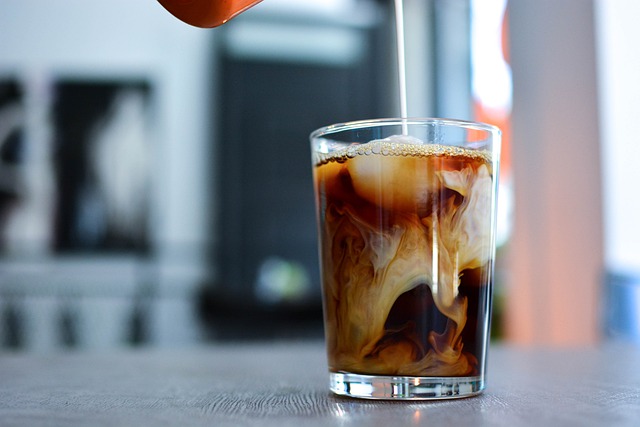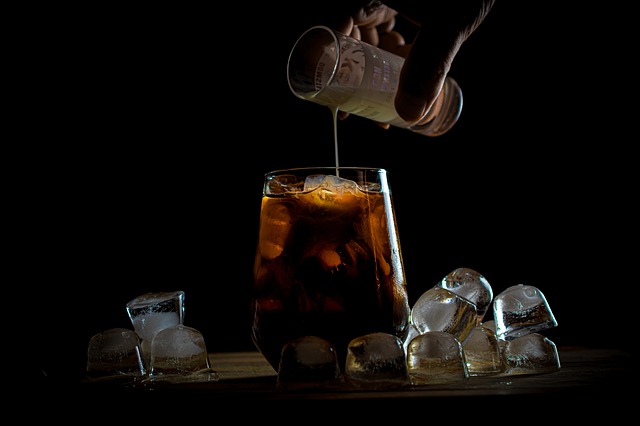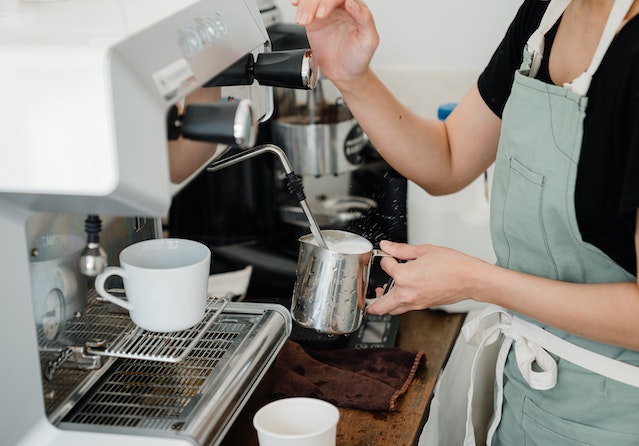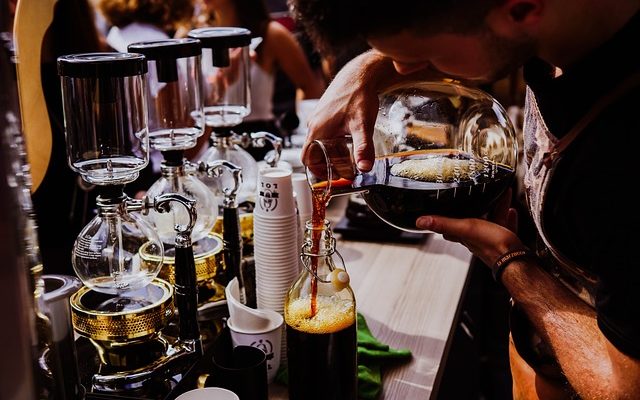With the hotter months in full swing, many of us are looking for a delicious way to stay cool and refreshed. Cold coffee is the answer! Not only can you enjoy that special kick from your favorite coffee blend, but making it couldn’t be simpler. In this article, we will walk you through one proven method for brewing cold coffee at home with minimal effort and necessary equipment.
Are you looking for a cold coffee that goes beyond the typical convenience store fare? If you’re after something smoother, more intense and delicious, then cold-brewing is an ideal method to try. Cold-brewing involves steeping freshly ground coffee in room temperature or cold water over an extended period of time—it’s slower and produces a naturally sweeter drink than traditional hot-water brewing methods. Not only does it provide a different flavor profile with your morning cup of joe, but it also offers some nutritional benefits; the rich antioxidants from cold-brewed coffee have been shown to be higher than those found in traditionally brewed java. So if you’re wanting something new and delightful in your caffeine kick, keep reading to learn all about this special brewing technique!
Table of Contents
The best brewing method for cold coffee is the Toddy cold brew system. It’s a simple, easy to use method that produces a really great cup of coffee. Keep reading…
What Is Cold Brewing?
Cold brewing involves steeping coffee grounds in cool or room temperature water for an extended period of time. This method produces a much milder, smoother cup of coffee than traditional methods, since the lower temperatures do not extract as many bitter and acidic components from the beans. Cold brewed coffee is also less acidic than hot-brewed and can be stored for up to two weeks without losing flavor or becoming stale. Additionally, cold brewing requires little energy – making it a great option for those looking to reduce their environmental impact. With its unique flavor profile, cold brew can be enjoyed on its own or incorporated into various types of drinks including lattes, cappuccinos and even smoothies! So, whether you’re looking for a way to cut down on your energy consumption or just want to try something new, cold brew coffee is a great option.
If you’re unsure of how to get started with cold brewing, don’t worry – it’s easy! All you need is some good quality coffee grounds (preferably freshly roasted and ground for the best flavor), a container of some sort (a French press or Mason jar will do nicely) and water (filtered if possible). Simply combine your coffee grounds and water in the container, stir everything together and let it steep at room temperature for 12-24 hours. Once that time has passed, strain out the coffee grounds using a paper filter or cheesecloth, pour into an airtight container and enjoy! You can also experiment with different ratios of coffee to water, steeping times and other variables in order to create a unique blend that is perfect for you. So why not give cold brewing a try today? With its minimal effort and energy requirements, you’ll soon be reaping the rewards of a deliciously smooth cup of coffee!
How Does Cold Brewing Coffee Compare To Other Brewing Methods?

Cold brewing coffee results in a beverage that is significantly lower in acidity than regular hot brewed coffee. This is because the cold water used for this method extracts fewer acids and oils from the beans compared to higher temperatures used with traditional brewing methods. Cold brew also produces a smoother, less bitter flavor as well as a thicker body without any additional cream or sugar needed. However, since it takes longer to make cold-brewed coffee, some people may find that it isn’t as convenient as other methods of brewing. Additionally, depending on the type of grind used and length of time the grounds are allowed to steep, cold brewed coffee can be overly concentrated. To ensure an optimal cup every time, many baristas suggest using specific types of grinds and timing to get the desired flavor profile. Finally, some types of coffees may not be suitable for cold brewing due to their unique characteristics, so it’s best to experiment with different types to find which beans produce the best results. Ultimately, there are many factors that can impact the quality of a cup of cold brewed coffee, but those willing to put in the extra effort will be rewarded with an incredibly smooth and flavorful beverage.
In conclusion, cold brewing coffee is a great alternative for those who are looking for a less acidic and smoother cup of joe. It requires a bit more time and experimentation than other methods—such as drip or French press—but the payoff is certainly worth it in terms of flavor. Those who want to try out cold brewing should begin by using a medium-coarse grind and steeping the grounds for at least 12 hours. From there, they can adjust the grind size or steep time depending on their desired flavor profile. With some practice, anyone can learn how to make delicious cold brew coffee in the comfort of their own home.
What Are Brewing Methods For Cold Coffee?
There are a variety of different methods for cold brewing coffee, but they all involve steeping the beans in cold or room temperature water over a long period of time. Commonly used techniques include:
– The Immersion Method – This is probably the simplest and most widely employed technique for cold brewing coffee. It involves submerging the ground coffee beans in cold or room-temperature water for 12 to 24 hours before filtering them off. This method produces a smooth and full-bodied cup that has less acidity than hot brewed coffee.
– The Sock Pot Method – Also known as ‘coffee sock’ or ‘filter bag’ method, this process requires placing ground coffee in a filter (usually made from muslin cloth) and then suspending it in cold or room-temperature water. The ground coffee will steep for 12 to 24 hours before filtering off the liquid. This method produces a cup that is mellow with low acidity.
– Cold Drip Method – Also known as ‘slow drip’ or ‘ice drip’, this technique utilizes a slow drip method over several hours, gradually dripping cold water over the coarsely-ground beans positioned in a filter on top of a collection vessel below. This method creates an incredibly smooth and full-bodied cup that has very little bitterness or acidity.
These are just some of the brewing methods available for making cold brewed coffee, each producing its own unique flavor profile depending on the chosen method and beans used. No matter the method, cold brewing is a great way to enjoy your favorite coffee without having to rely on hot water. So get creative and experiment with different techniques to find the one that suits you best!
No matter what brewing method you choose, the result should always be delicious and full of flavor! With so many options to choose from, you can easily craft a cup of cold brew to your exact preferences. Experiment with different methods, grinds and steep times until you find the perfect combination for your taste buds!
What Are The Benefits Of Cold Brewing Coffee?

Cold brewed coffee has become increasingly popular due to its smooth taste and complex flavor. Unlike hot brewing methods, cold brewing does not use heat to extract the flavors from the coffee grounds. Instead, it relies on a slow steeping process that can take up to twelve hours to complete. This slow infusion method allows for more delicate flavors such as fruit and floral notes to be extracted without the harsh bitterness associated with hot brewed coffee. The result is a cup of coffee that is smoother, sweeter, and less acidic than traditional hot coffee brews.
Cold brewed coffee also offers several health benefits due to its low acidity levels. Cold brewing reduces the amount of acids in the finished beverage which may help people with sensitive stomachs enjoy their favorite cup of joe without any issues. Cold brewing also retains more of the antioxidants found in coffee beans than hot brews, meaning that cold brewed coffee packs a bigger health punch.
In addition to its taste and health benefits, cold brewed coffee is also easier to make and store than traditional hot coffees. All you need are coarsely ground coffee beans, water, and your favorite cold brewer device. Steeping the grounds for 12-24 hours will give you a full-bodied cup of deliciously flavorful cold brew that can be stored for up to two weeks without losing freshness or flavor. With no heating involved, you don’t have to worry about burning yourself when preparing your morning cup either!
Whether you’re a coffee connoisseur or just someone looking for an easier way to make delicious brew at home, cold brewed coffee is an excellent choice. Its smooth flavor and health benefits make it a popular choice with hobbyists and professionals alike. If you’ve never tried cold brewing before, give it a try – you won’t be disappointed!
What Is The Best Coffee Bean For Cold Brewing?
When it comes to cold brewing coffee, the best beans are those that have been roasted medium or dark. Dark roast beans can provide an intense flavor profile with a high concentration of oils and acids. Medium roast coffees are usually more balanced in flavor, yet still with a full-bodied body and aroma.
Both types of roasts deliver complexity and depth of flavor, so which type you choose ultimately comes down to personal preference. Many cold brewed coffees include both light and dark roasts for this reason, as the combination provides a diverse array of flavors that can be enjoyed.
In many cases, specialty coffe beans from countries such as Ethiopia, Columbia, Kenya and Brazil offer unique flavors that can be hard to find in more traditional coffee roasts. These beans are perfect for cold brewing, as their flavors shine through without the addition of heat.
No matter which type of bean you choose, make sure to buy freshly roasted beans that have been stored in an airtight container away from direct sunlight and moisture. This will ensure that your coffee has the best flavor and aroma when it is brewed.
Ultimately, choosing the right beans for cold brewing comes down to experimentation and personal preference. Talk to experts at your local coffee shop or roastery and find out what they recommend, then try different varieties and decide which one tastes best to you!
How Do I Cold Brew Coffee At Home?

Brewing coffee at home with a cold brew method can be done in a few simple steps. Cold brewing is a slow process that steeps and infuses the beans in cold water for an extended period of time. In the end, you get a smooth and less acidic cup of coffee. Here are the basic steps to make your own cold brew coffee:
– Grind your beans – Use medium-coarse grounds for best flavor extraction.
– Add your grounds to a pitcher or French Press – You should use 1/4 cup per quart of filtered water (or 8 tablespoons per litre).
– Stir thoroughly – Make sure all the grounds are fully saturated in order to evenly extract the flavors from them.
– Cover and let steep – Leave the mixture for 12-24 hours, depending on your desired strength.
– Strain the grounds – Decant the liquid into an airtight container to be stored in the fridge or use a French press plunger to separate the grounds before pouring.
– Enjoy – You can drink cold brew concentrate as is or dilute with milk or water to your taste. Enjoy!
By following these steps, you can make delicious cold-brewed coffee right at home in just a few simple steps! With this method of brewing, you get a smooth cup of coffee that’s free from bitter acidity and has a rich flavor. Give it a try today and enjoy your perfect cup of cold brew!
How Much Coffee Should I Use For Cold Brewing?
When cold-brewing coffee, it is important to determine the correct amount of coffee grounds needed. The ratio of ground coffee to water should be between 1:4 and 1:8, depending on the strength you are looking for in your finished cup. For a medium-strength cup, we recommend starting with 4 ounces (or about 2/3 to 3/4 cup) of coarsely ground coffee for each quart of cool or room temperature water. If you want a stronger brew, increase the ratio slightly; if you want something milder, decrease it somewhat. You can also experiment with different brewing methods and times until you find the perfect combination that suits your taste. It is best to start out by using slightly less than what is recommended so that you can adjust as needed. Once you have the ratio just right, make sure to measure and record it for future use! With a bit of experimentation, you can easily master the art of cold-brewing coffee.
What Is The Best Grind For Cold Brewing Coffee?

The best grind for cold brewing coffee is one that is coarse and even. Cold brewing requires a longer steep time, so using a finer grind would result in over-extraction and an unpleasantly bitter cup of coffee. On the other hand, an uneven grind can be difficult to filter out, resulting in an extremely muddy beverage.
For best results, you should use a burr grinder instead of a blade grinder. This will ensure that all of your grounds are uniform in size, allowing for even flavor extraction during the long brew time. A medium-coarse setting is often recommended for cold brews, as this will give you the perfect balance between extraction and clarity of flavor. If you have access to a grinder that allows you to adjust the grind size, you can experiment with coarser and finer settings until you find the one that works best for your taste.
By carefully selecting the right grind for cold brewing coffee, you can create a cup of java that is smooth and balanced in flavor. With a little bit of experimentation, you’ll be able to find the perfect grind setting for your cold brew recipe!
Additionally, it’s important to consider how long your chosen grounds will stay fresh after grinding. Coffee beans release their flavors and aromas over time and become stale when exposed to air. If using pre-ground beans or purchasing from a specialty store, make sure to check the expiration date to ensure that you are getting the most flavor out of your coffee.
Ultimately, the best grind for cold brewing coffee is one that is coarse and even in size. With a carefully selected grind setting and fresh beans, you can create an amazing cup of cold brew that will be sure to delight your taste buds!
>>> You may like this:
Best nitro cold brew coffee maker
How To Cut Your K Cup Costs In Half?
How Much Instant Coffee You Need Per Cup?
How Long Should I Let My Coffee Cold Brew?
When it comes to cold brew coffee, patience is key. Generally speaking, it is best to let your cold brew steep for 16-24 hours. This ensures that all of the flavorful compounds have had an opportunity to dissolve into the liquid and provide a full flavor profile for you to enjoy.
If you are in a hurry and don’t have time to wait for long brewing times, you can reduce the waiting period by using more coffee grounds in the ratio or grinding your beans finer than usual. By doing this, extraction will be faster and you will still get delicious results in shorter amounts of time.
It is important to note that the longer your cold brew steeps, the stronger its flavor profile becomes. If you find the flavor to be too strong for your liking, you can always dilute it with hot water or milk.
No matter what brewing method you choose, follow the instructions carefully and taste-test as you go along. With some patience and a few adjustments, you can produce delicious cold brew coffee in no time!
What Is The Ideal Water To Coffee Ratio For Cold Brewing?
When it comes to cold brewing, the ideal water-to-coffee ratio is 1:4. That’s one part ground coffee to four parts cold filtered water. This helps ensure that you get a smooth and flavorful cup of coffee. Because cold brewed coffee has a lower acidity than hot brewed varieties, many people prefer it for its milder taste. Additionally, since the grounds are steeped in cold water for an extended period of time, more of the natural flavors and aromas are released into your cup without any bitterness or acidity. Therefore, using this specific ratio ensures that those flavors are properly extracted and balanced within your brew.
It is also important to note that when using a standard recipe, the grind size of the coffee is also crucial to success. If the grind size is too coarse, the water will pass through too quickly, yielding an under-extracted cup of coffee. On the other hand, if your grind size is too fine, it can cause over-extraction and bitterness. Therefore, you should aim for a medium-fine grind when cold brewing.
Finally, be sure to keep in mind that this ratio may need to be adjusted slightly based on personal preference. You can experiment with different ratios until you find something you like best. Ultimately, finding the perfect balance between time and taste should always be your goal when cold brewing.
>>> See more: How to: Three Ways to Cold Brew Coffee (The Best Iced Coffee Ratio: Brewing Method for Cold Coffee)
How Do I Store Cold Brew Coffee?
The best way to store cold brew coffee is in an airtight container, such as a Mason jar or vacuum-sealed bottle. Choose a container that is large enough to hold all of your cold brew, and make sure the lid seals tightly so no air can get in. If you’re using a Mason jar, consider adding a plastic lid as opposed to the metal one for extra insulation. Additionally, it’s important not to store your cold brew in direct sunlight or near heat sources as this will cause degradation of flavor over time. The optimal temperature range for storing cold brew coffee is between 35°F and 50°F (2°C and 10°C). It should also be stored in a refrigerator if possible. When stored properly, cold brew coffee can last up to two weeks without any significant degradation in flavor. If you’re unsure of when the coffee was made, it’s best to discard it after a week or so. To get maximum enjoyment out of your cold brew coffee, enjoy it as fresh as possible!
Finally, if you need to make a large batch of cold brew and don’t anticipate finishing it within a couple days, consider freezing some of the mixture in an airtight container. This will help preserve the flavor and ensure that you have some on hand for whenever you need it! Always remember to thaw frozen batches slowly in the refrigerator before consuming. With these tips in mind, you can easily store cold brew coffee and enjoy it for weeks to come.
Conclusion: The best way to make cold brew coffee is with the immersion method. This involves steeping coarsely ground coffee beans in room-temperature water for 12 hours or more, then filtering out the grounds and enjoying your concentrate diluted with milk, water or over ice. The French press method also works well, but requires a little more attention and care. If you don’t have time to make your own cold brew at home, there are plenty of great store-bought options available these days. Just be sure to check the label to make sure you’re getting 100% Arabica beans – anything less and you might as well just drink iced regular ol’ Joe.
Welcome to the Café Toscana Restaurant blog! Here we’ll be sharing all the latest news and information about our delicious Italian cuisine. We hope you’ll enjoy reading and please feel free to share with your friends!

